Streams are span queries that retain their data beyond the default three-day Microsatellites retention window. They allow you to proactively monitor parts of your system that are crucial to business health. Cloud Observability continuously receives data from your Microsatellites that match the query and stores statistics and example traces to ensure you always have data for latency, error rate, and operation rate for as long as your Data Retention policy allows.
Queries for alerts are automatically saved as Streams.
Using Terraform? You can use the Cloud Observability Terraform provider to create and manage your Streams. You can also use it to export existing dashboards and alerts into the Terraform format.
In a Stream, the percentiles are based on analyzing 100% of the data sent to Microsatellites. Every minute, Cloud Observability captures exemplar traces from each latency point (similar to the latency buckets in the Explorer histogram), being sure to pull more exemplars that have errors or higher latency. Because Cloud Observability captures spans across the latency distribution, it doesn’t matter if your distribution is 100ms to 1s or 10s to 100s. Any outliers or errors are reported.
For example, here’s a Stream for the performance of the /api/get-profile operation on the android service: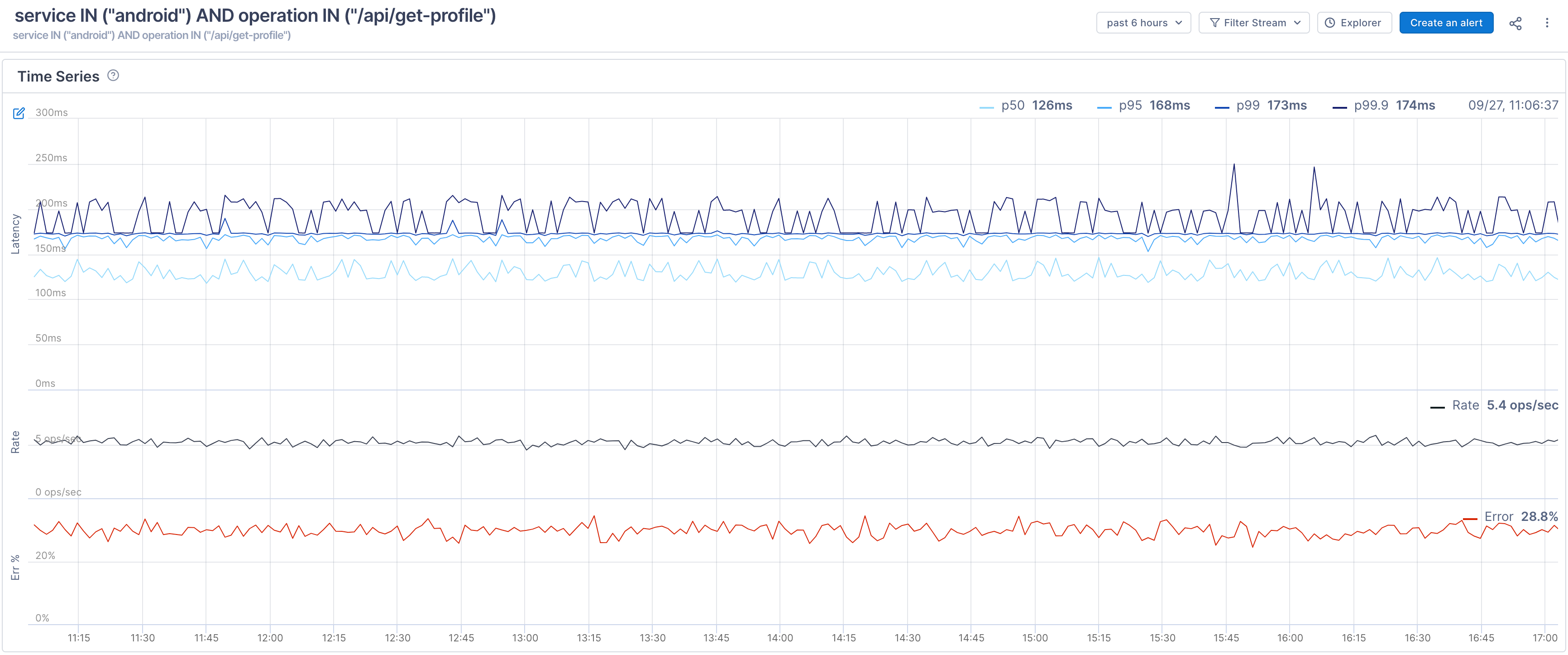
The first time series shows latency over a period of time. At the top, you can see the average duration of spans in the p50, p90, p99, and p99.9 buckets. The second series shows the operation rate over time, and the bottom series shows the error percentage rate over time.
When you hover over the latency series, you can view individual spans as dots in a scatterplot. This makes it very easy to see the actual distribution of latency and immediately notice outliers. Dots in red are spans with errors. You can click on any of the dots to open the full trace in Trace view. 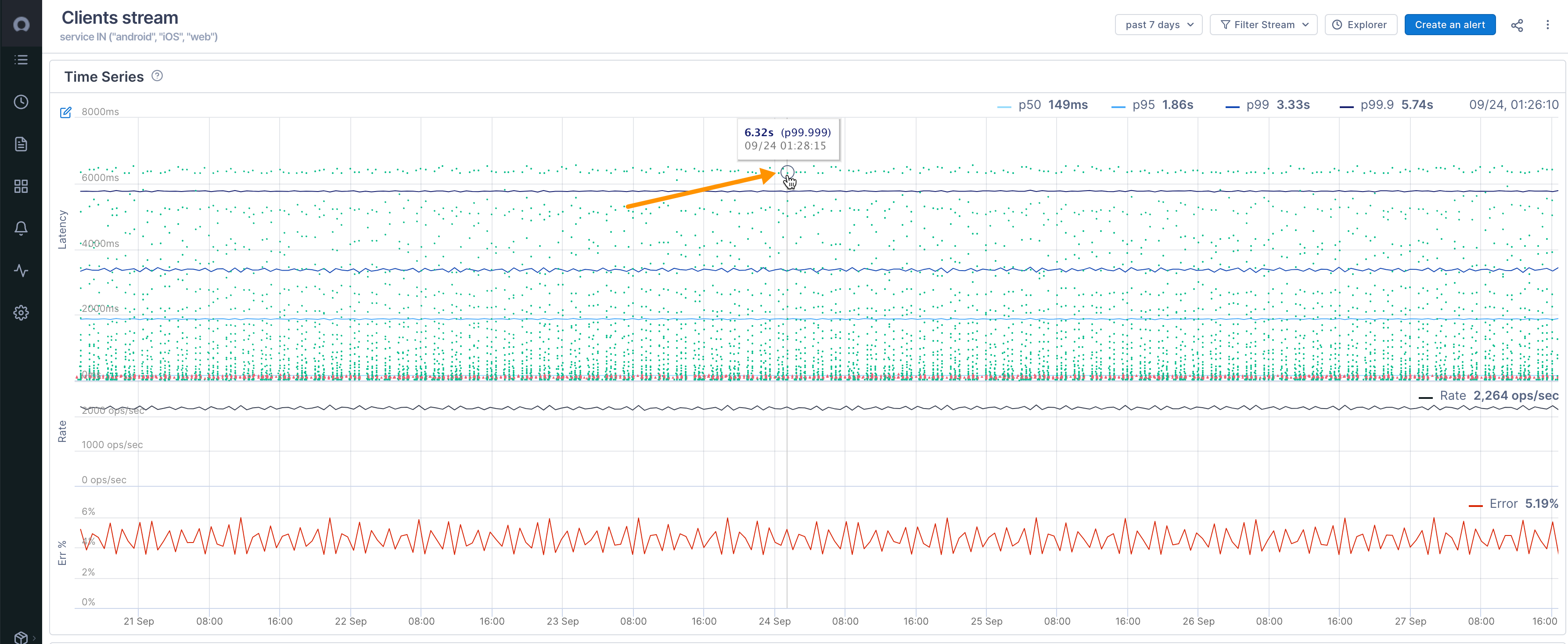
Below the time series is the Historical Spans table that displays the spans used to create the stream (it uses the same functionality as the Trace Analysis table in the Explorer view). You can click a span to view the full trace in Trace View . Spans with errors are shown in red. 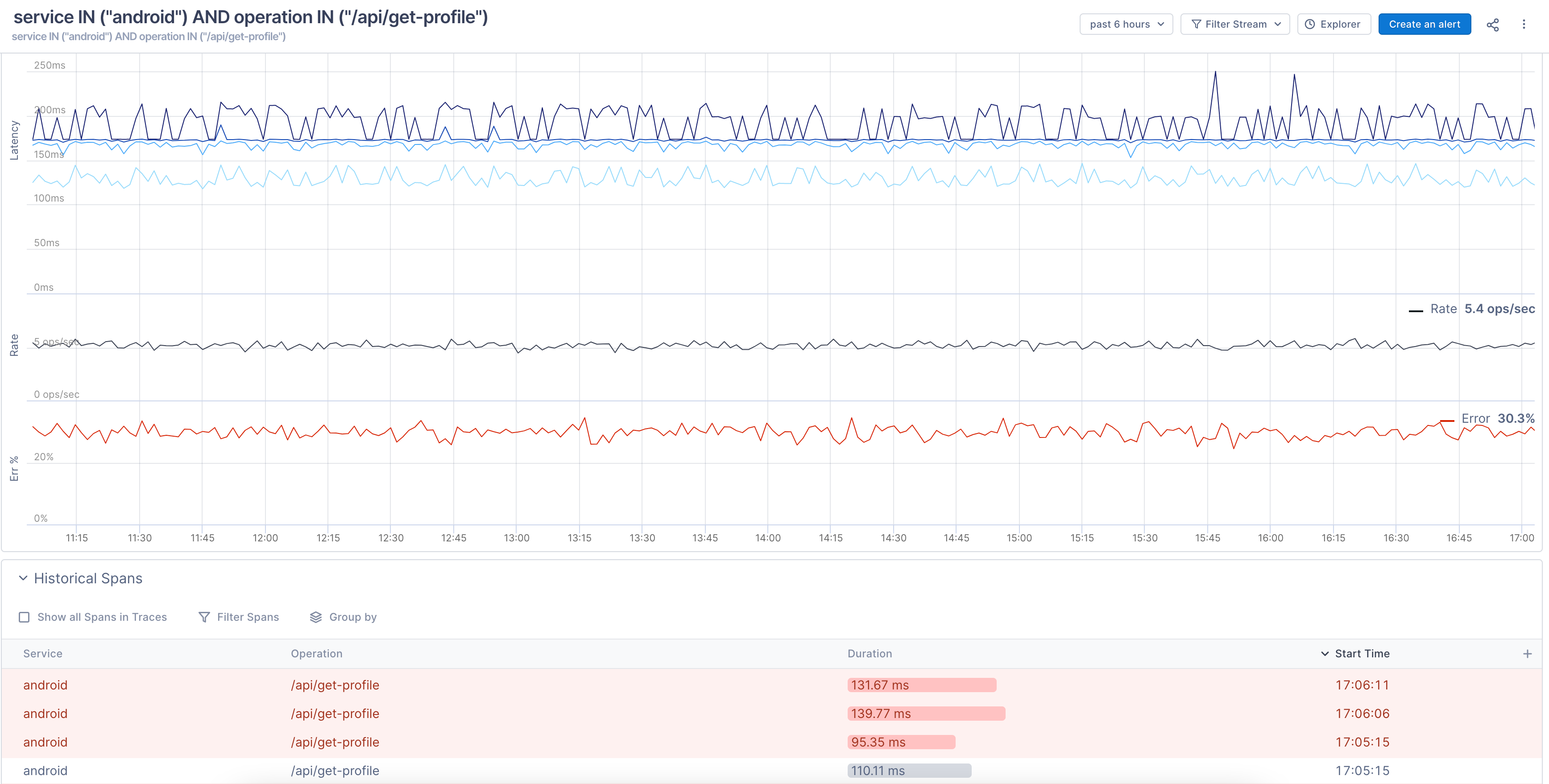
To help with issue mitigation, spans in the Historical Spans table may contain more exemplars of errors or latency and so may not reflect true percentage rates.
Once you’re done creating Streams, consider bundling them into dashboards adding alerts to notify team members when thresholds in a Stream are crossed. You can also embed Streams into many third-party applications.
Cloud Observability starts collecting data for Streams once you create them, so when you create a Stream and view it in a tri-chart, it will initially be blank.
The Streams list shows all Streams that currently exist for the project. For each Stream, you can view when data was last received for it, the date it was created, and who created it. 
Create a Stream
You create a Stream based on queries to your span data. Cloud Observability continuously monitors for span data that matches that query and saves it as a Stream. You can create a Stream from the Streams view, from your Query in Explorer, or from the Service Directory.
Use our public API to list, retrieve, update, and create Streams. You can also retrieve a specific time series for a Stream.
Create a Stream from the Streams view:
-
From the Stream list, click Create Stream.

-
Enter a query to base your Stream on and click Run Query. Cloud Observability runs the query and returns example spans.

To run a query using the Query Builder:
Click into the search bar to open the Query Builder. You can build queries for services, operations, and attributes. UseINorNOT INto build the query. When you click into the Service or Operation field, the builder displays valid values.
When you add multiple values to the Operation field, spans that match either value (ORoperation) are returned.
Learn more about running queries
Supported query keys
Query multiple keys and values -
If the results are satisfactory, click Create stream. The Stream is added to the list of Streams. By default, the Stream’s name is the query. You can rename it.
-
To view the Stream, click VIEW STREAM in the banner or click its name in the list.

Cloud Observability starts collecting data for Streams once you create them, so when you create a Stream and view it in a tri-chart, it will initially be blank.
Create a Stream from Explorer:
-
Open Explorer from the navigation bar and run any query.
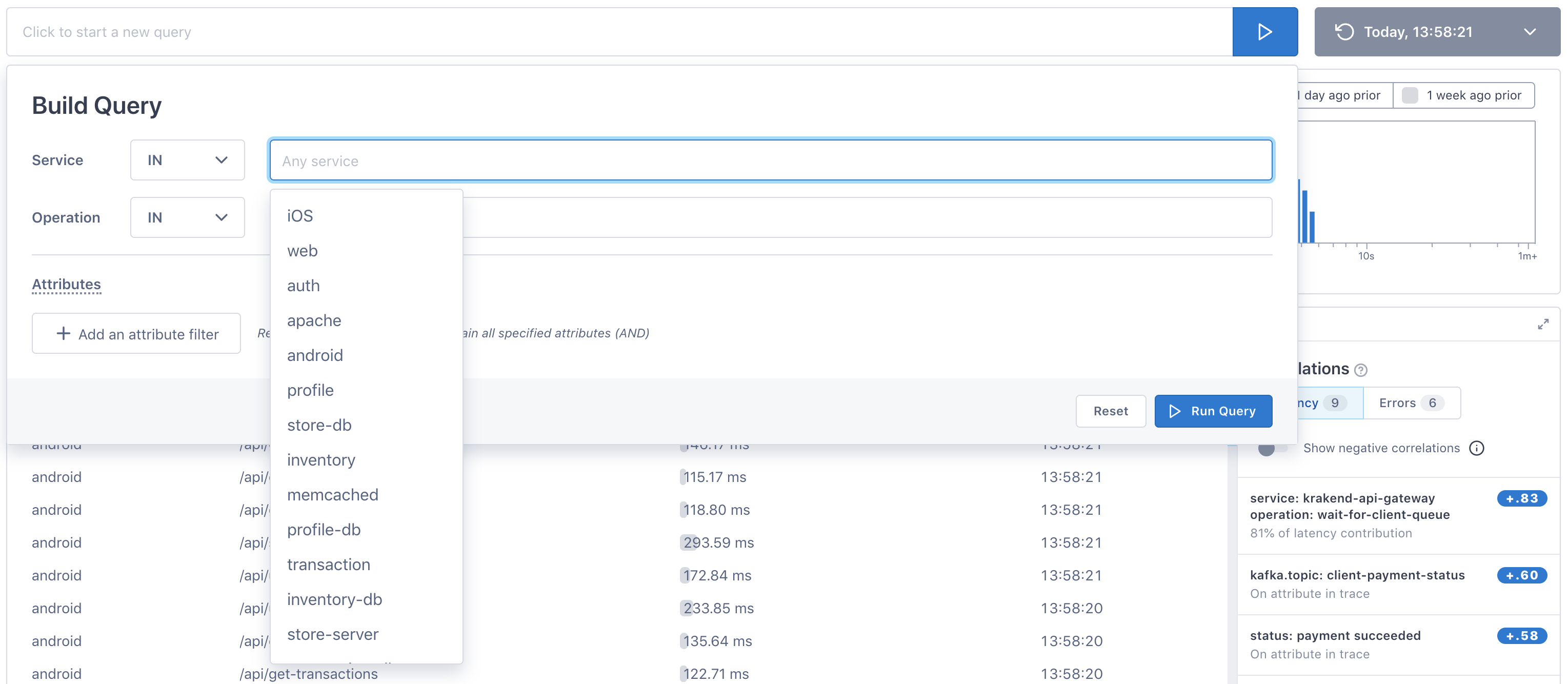
To run a query using the Query Builder:
Click into the search bar to open the Query Builder. You can build queries for services, operations, and attributes. UseINorNOT INto build the query. When you click into the Service or Operation field, the builder displays valid values.
When you add multiple values to the Operation field, spans that match either value (ORoperation) are returned.
Learn more about running queries
Supported query keys
Query multiple keys and values -
Once the query is run, click Create Stream.

If the button is grayed out, then a Stream already exists for that query.
-
To view the Stream, click View Stream.

-
By default, the Stream takes the name of the query. You can change that to be more descriptive by clicking into the title and entering a name of your choice.

Cloud Observability starts collecting data for Streams once you create them, so when you create a Stream and view it in a tri-chart, it will initially be blank.
Create a Stream from the Service directory:
-
Open the Service Directory from the navigation bar, click the Operations tab and choose any service on the left.
-
To create a Stream for an operation on a service, Click Create Stream for that operation (if the button says View Stream then a stream has already been created for this operation).

-
To create a Stream for the service, click the Streams tab and click Create Stream.

-
To view the Stream, click VIEW STREAM in the banner or click View Stream in the list. By default, the Stream’s name is the query. You can rename it.
Regardless of how you create the Stream, you won’t see much data at first because the Microsatellites have just been told to start collecting it. Over time, the Stream becomes more populated. 
Filter data on a Stream
By default, Cloud Observability displays all data for a Stream from the last 24 hours. You can change that time period. You can also filter the data by errors, percentiles, and duration.
Filtering a Stream also filters the data in the Historical Spans table.
Filter by time
Use the time period dropdown to choose a different period or enter a custom time period. Click Pick Time Range to enter a custom time period from a calendar. The time series and the Historical Spans table redraw to show spans just from that time period. 
Changing the time window may affect the alignment of the data points and show different results.
Filter by Errors
To view spans with errors, use the Filter dropdown and choose Errors. The series redraws to display only data for spans with errors and the Historical Spans table shows the spans with errors. 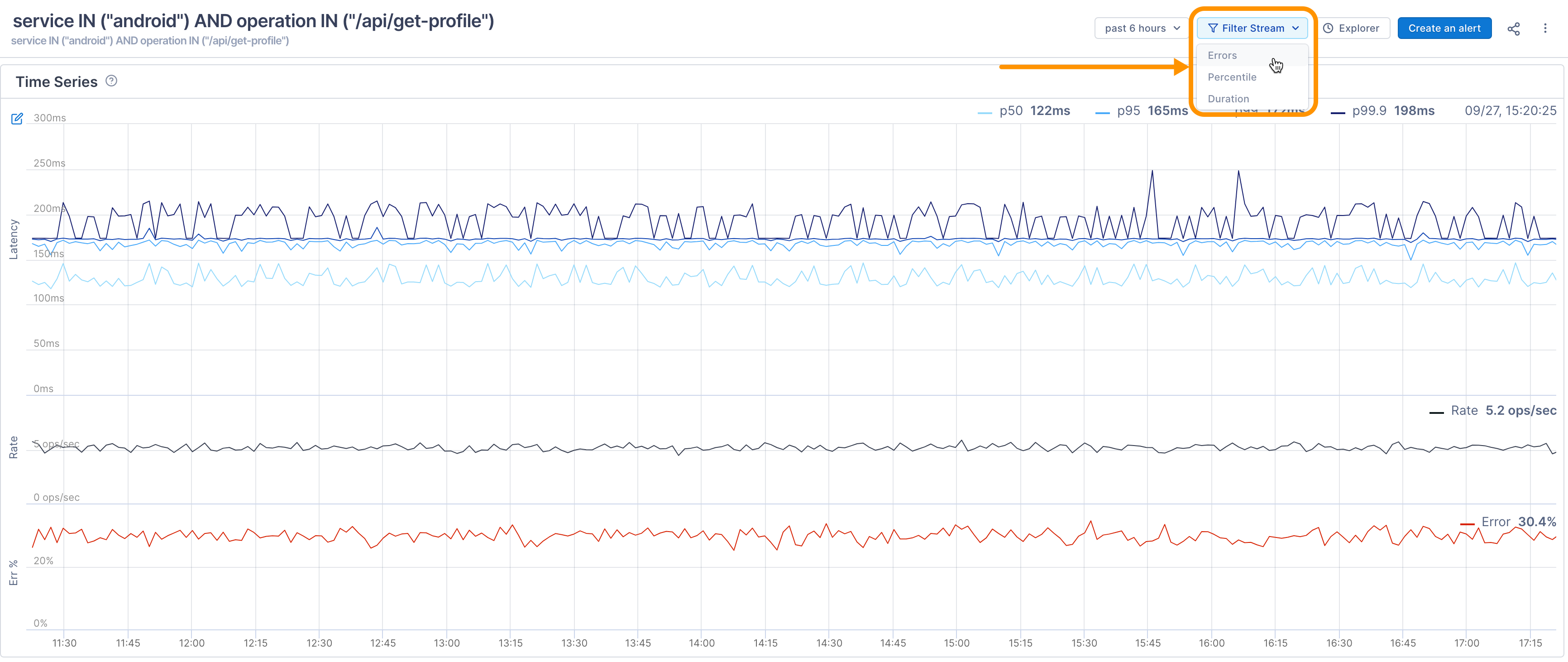
The scatterplot of spans does not display when filtering by errors.
Filter by latency percentile
By default, Cloud Observability displays lines for the p50, p90, p95, and p99 latency percentiles. You can filter the data to display a specific percentile and above. Use the Filter dropdown and choose Percentile. Enter a value and Cloud Observability redraws the graph and table to show just that percentile and above. You can change the value by clicking it to reopen the dialog.
For example, this data is filtered to show p99.5 and above. 
Filter by duration
By default, Cloud Observability shows all spans, regardless of duration. Use the Filter dropdown, choose Duration, and enter a time period to see where that duration lies in the time series. Cloud Observability redraws the graph to show where that duration lies, and the scatterplot only shows spans at or above that duration. The table shows spans lasting approximately that duration. You can change the value by clicking it to reopen the dialog. 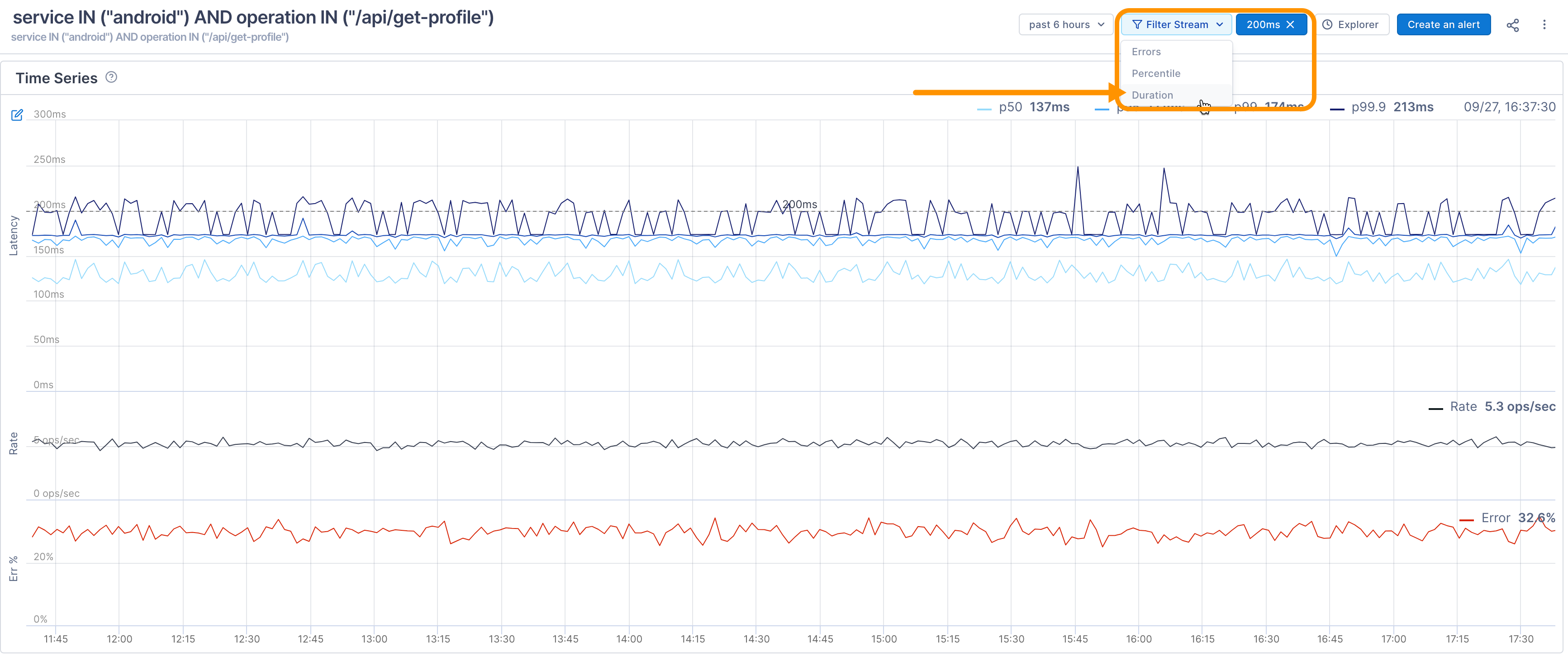
Analyze span data
The Historical Spans table shows information from a sample of spans used to create the Stream. By default, the table shows the service; the operation reporting the span, the span’s duration, and the start time. You can add other columns as needed. 
When you click on a span, you’re taken to the Trace view where you can see the span in the context of the full trace. 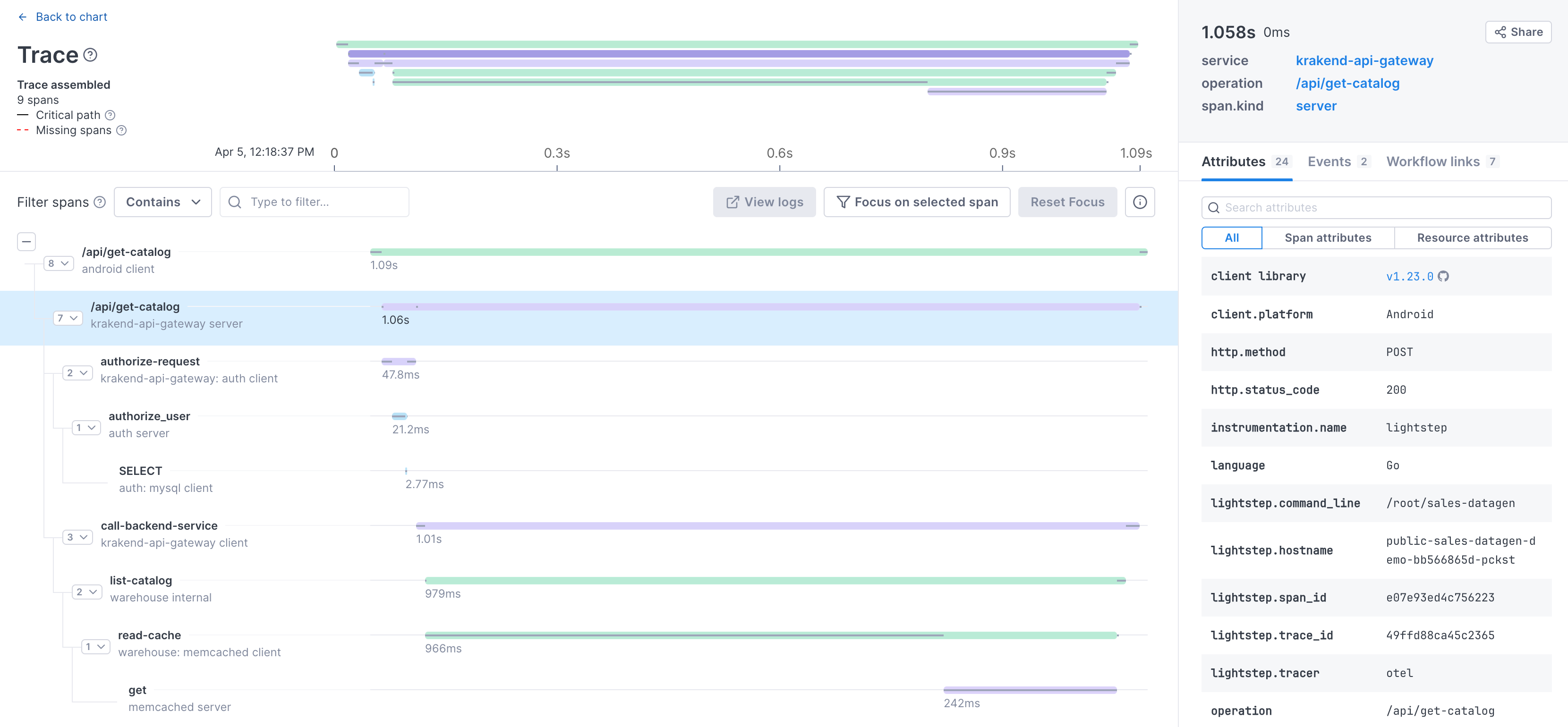
Add all spans from the trace to the table
By default, Cloud Observability only shows spans that match your Stream’s query. But often, you’ll want to see spans that participated in the same traces as the spans returned by your query. For example, if you’re trying to reach a hypothesis, you may want a more broad view of what is going on in a trace, without having to open a bunch of traces yourself.
To see all spans that took part in a trace with your query results, select Show all Spans in Traces. 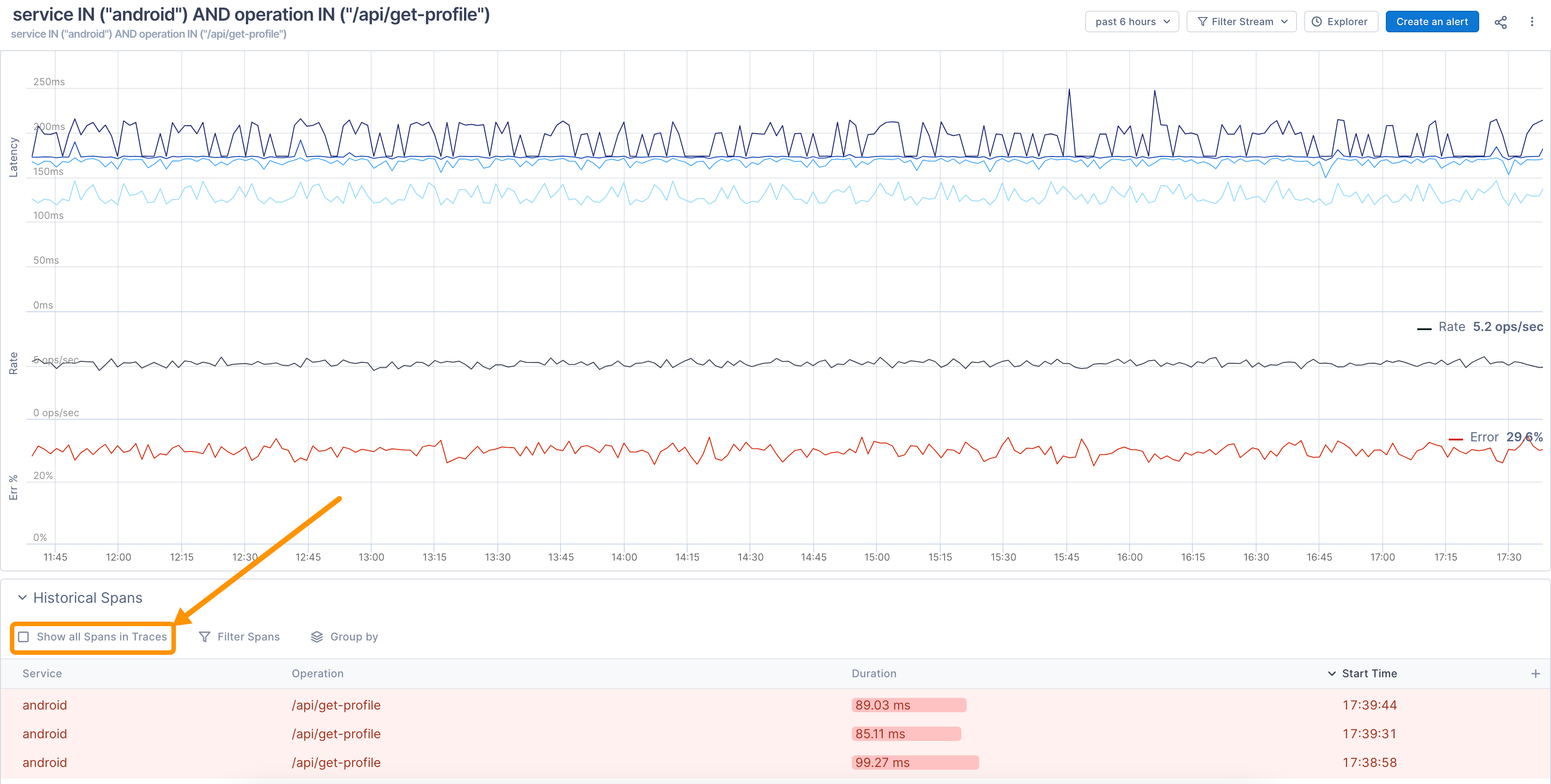
Add more columns to the table
You can add columns that show the span’s attribute data to the right of the table by clicking the + icon. As you start typing, Cloud Observability finds attributes matching your search. 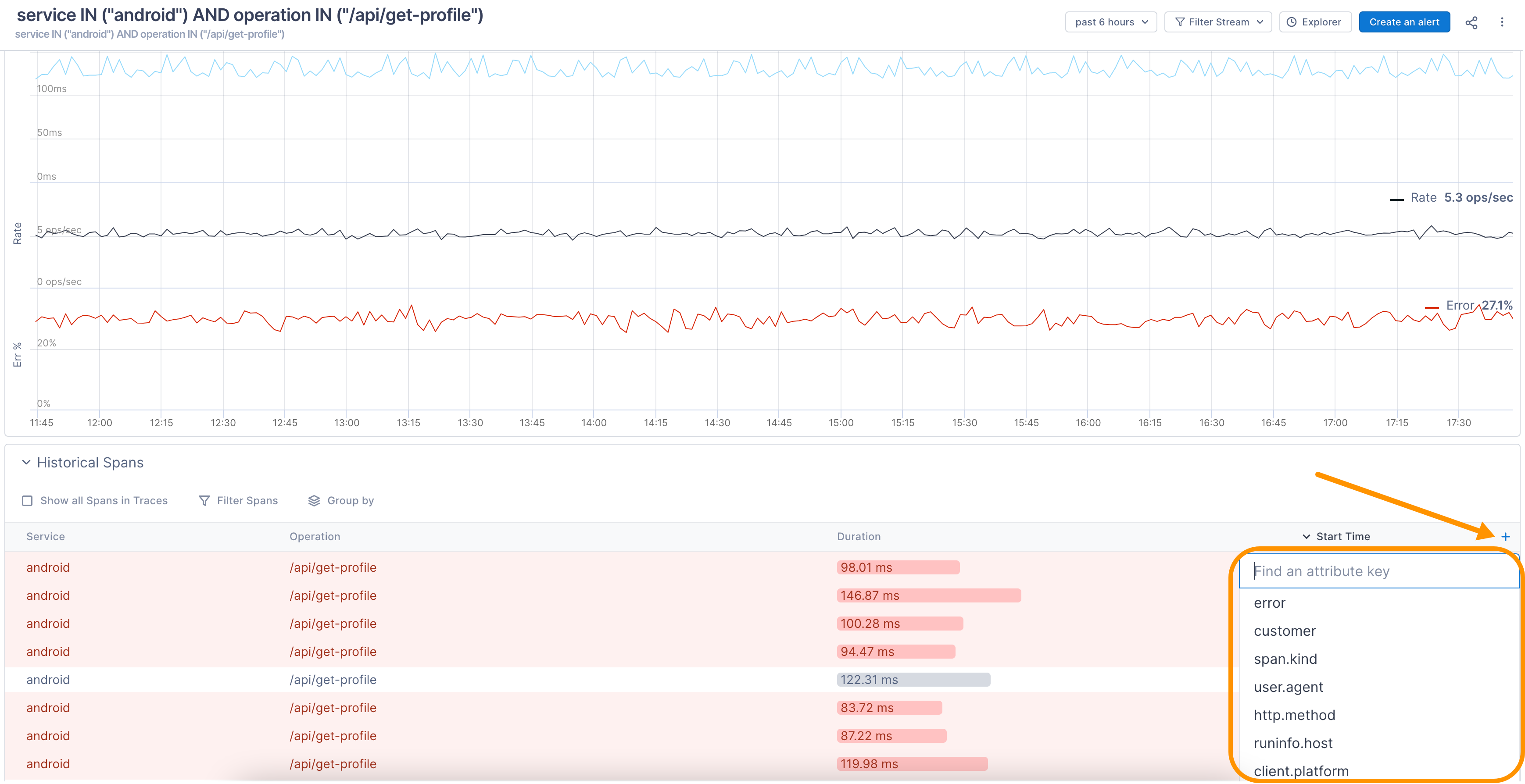
Filter data
You can filter the data in the Historical Spans table by Service, Operation, or Attribute.
Filtering the table does not affect the data shown in the time series charts.
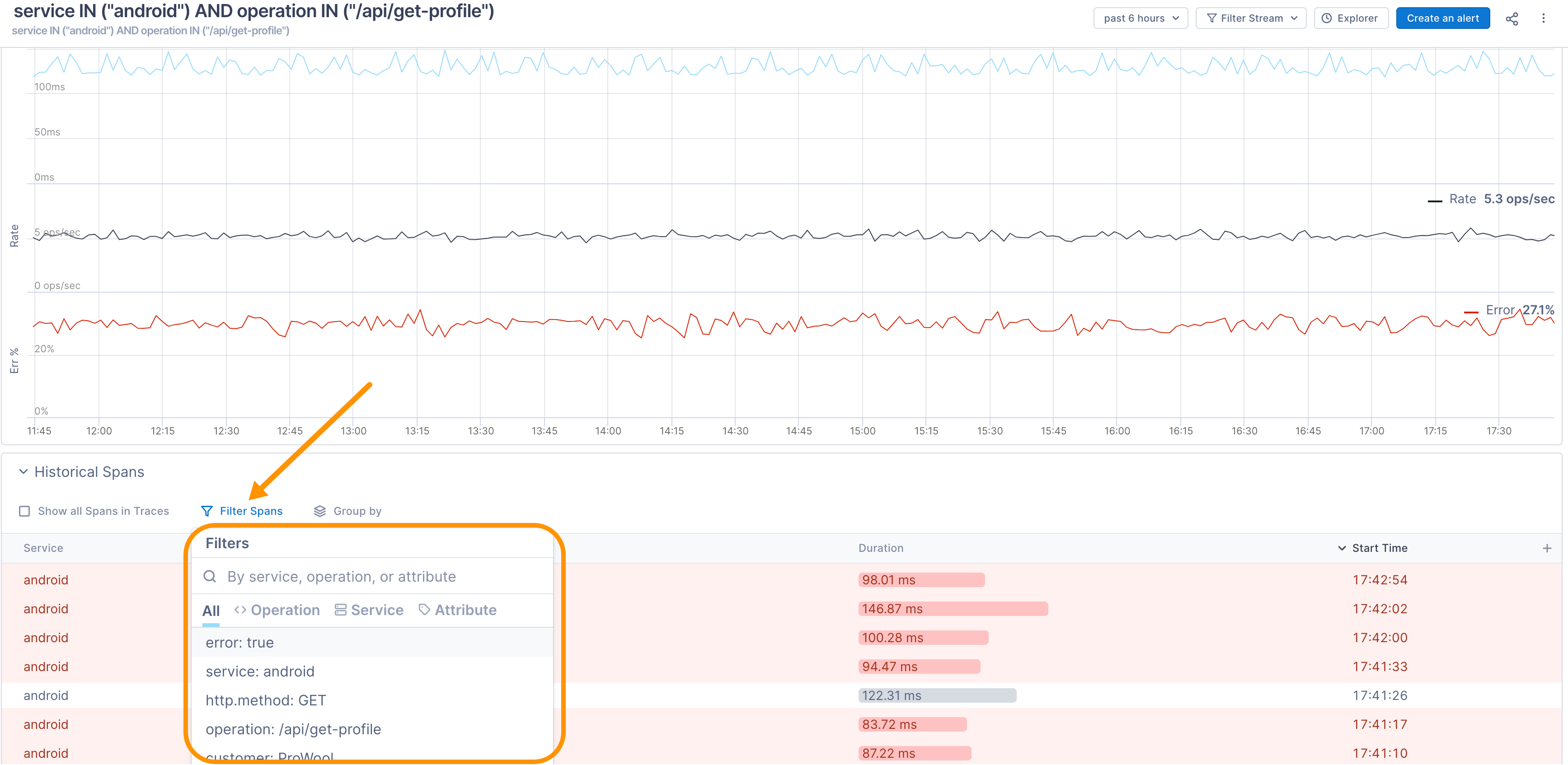
Group results
You can group your results to see interesting aggregate data about your spans. You can group by service, operation, or attribute. 
When you group your results, the table shows each value on the spans for the attribute, as well as average latency, error %, and span count. 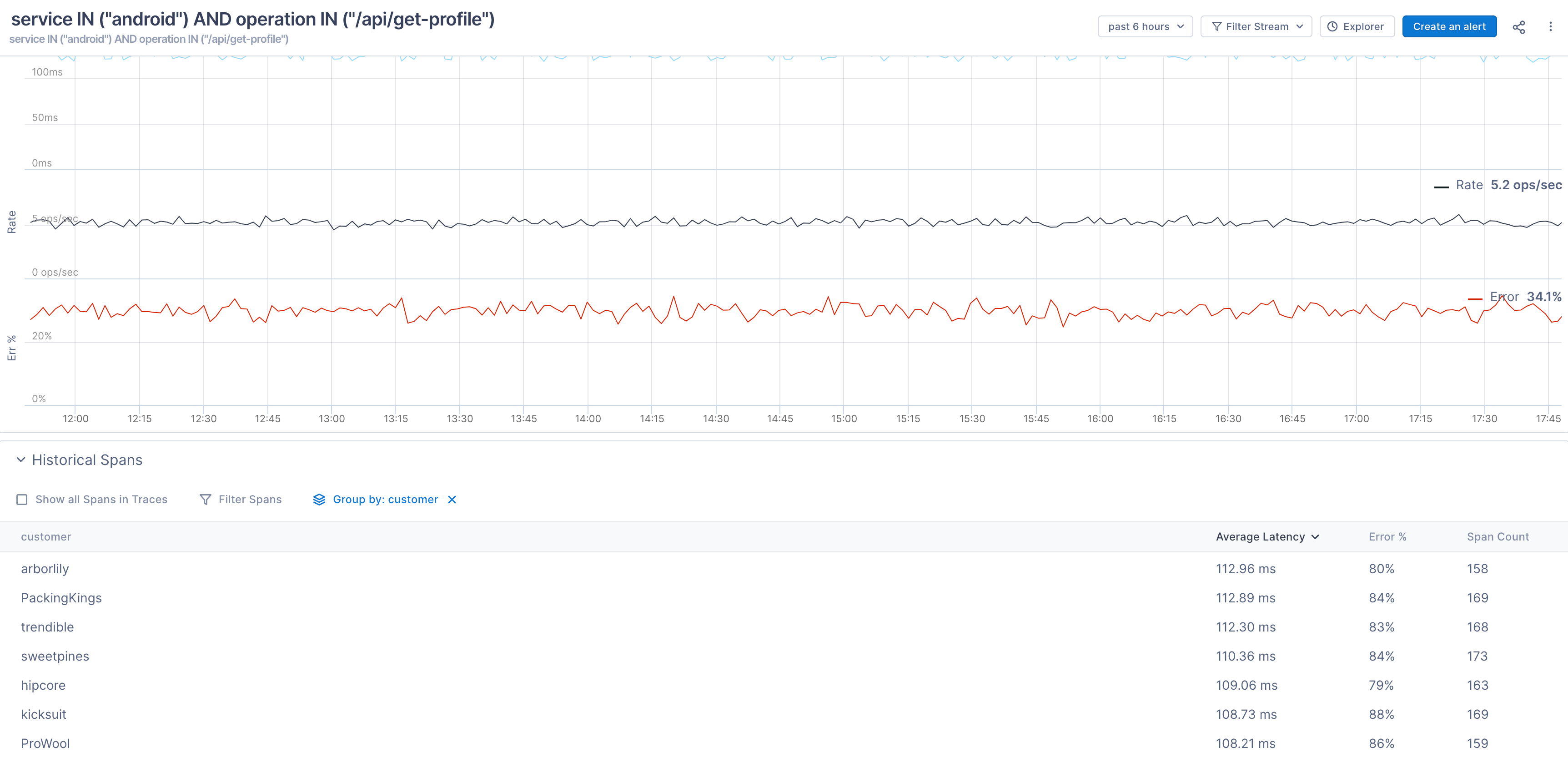
To help with issue mitigation, spans in the Historical Spans table may contain more exemplars of errors and so may not reflect the true percentage of error rates.
Click on a group to see the spans belonging to that group. 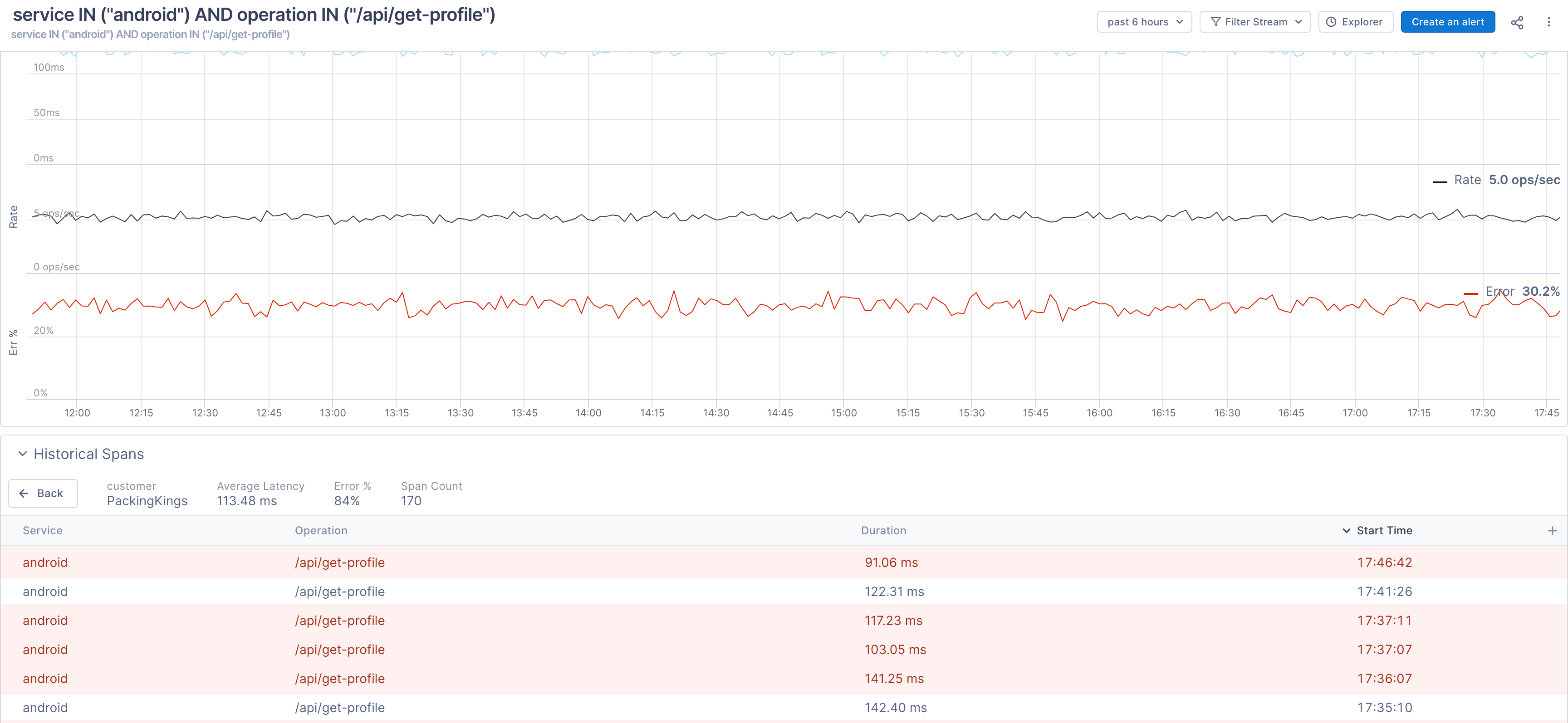
View all Streams
You can view all Streams created for your Organization from the Streams view. Click Streams from the navigation bar. 
Streams are listed in alphabetical order. Use the search bar to find Streams quickly.
Rename a Stream
By default, Streams are given the query parameters as the name. You can change that to be more descriptive by clicking the hamburger icon and choosing Rename. 
Delete a Stream
You can delete a Stream by clicking the hamburger icon for the Stream on the list view and choosing Delete.
Deleting a Stream also deletes all historical data persisted for that Stream and can’t be undone, so be sure you want to delete it!

You can bulk delete streams by selecting them and clicking Delete selected Streams.
Share a Stream
The URL for a Stream is stable and shareable; perfect for alert messages, slack messages, and bot auto-responses. You can share a shortened URL for the Stream by clicking the Share button. 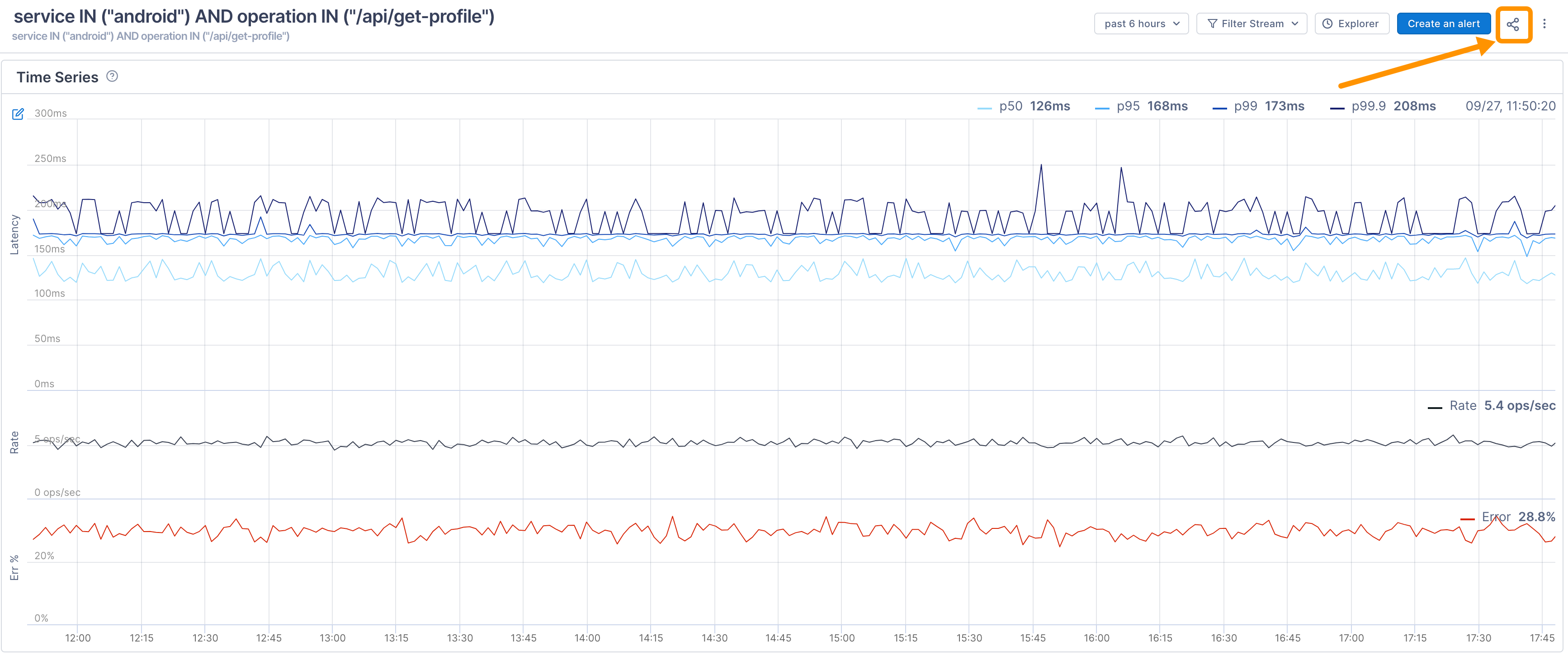
When you integrate Cloud Observability with Slack, you can share a preview of the Stream in any channel of your workspace. Simply paste the URL from the the Share button into a Slack channel. Other Slack members can see the Stream and Cloud Observability users can click View Stream to jump right to that page. 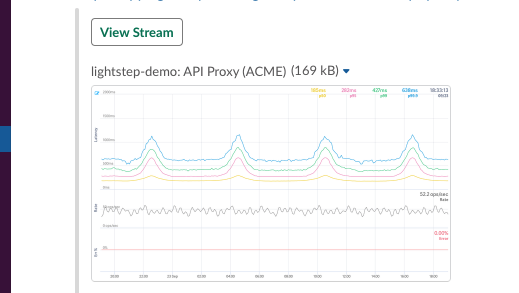
Add a Stream query to a notebook
You can add a Stream’s query to a notebook for when, during an investigation, you want to be able to run ad hoc queries, take notes, and save your analysis for use in postmortems or runbooks. Notebooks allow you to view metric and trace data from different places in Cloud Observability together, in one place.
To add to a notebook, click Investigate > Add to notebook and search to choose an existing notebook or create a new notebook. 
When you add to a notebook, a chart is created using the same query. You can see the latency for multiple percentiles and view exemplar traces. 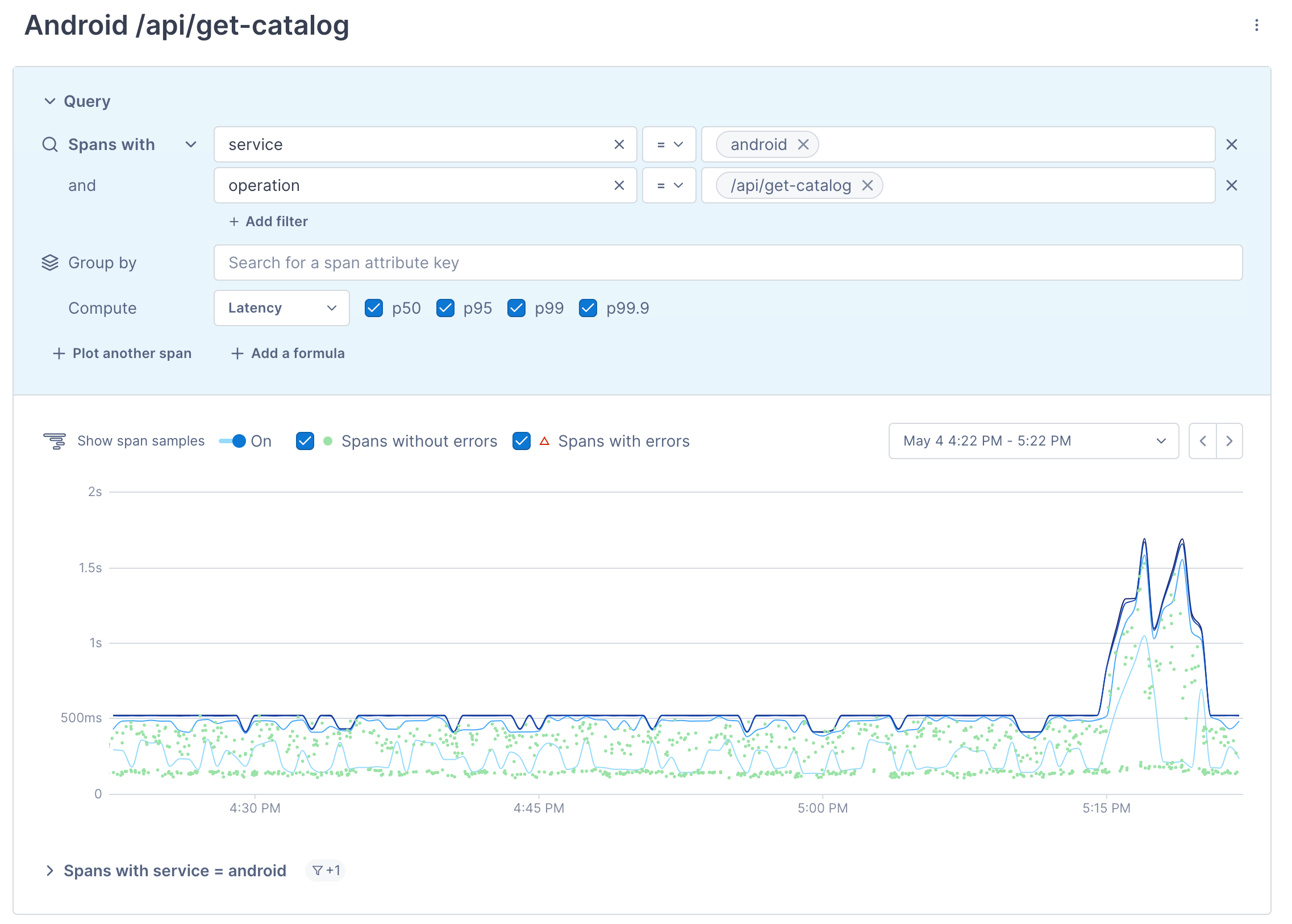
Run a Stream’s query in Explorer
If you want to view a Stream’s span data in Explorer, you can run the query right from the Stream list view. Click the hamburger icon for the Stream and choose Go to Explorer.
Embed a Stream in third-party apps
You can embed a Stream into any app that supports adding an <iframe> object. By default, the Stream uses the light theme currently displayed in Cloud Observability, but you can embed a dark-themed version instead.
Use our Grafana plugin to view Streams in Grafana. Once in Grafana, clicking on a Cloud Observability panel takes you back to Cloud Observability where you can view sample traces.
To embed a Stream:
-
Open the IFrame URL dialog to copy the code for the Stream. You can find the code to embed the Stream in two places:
From the Stream, at the top, click the Hamburger icon then Embed.
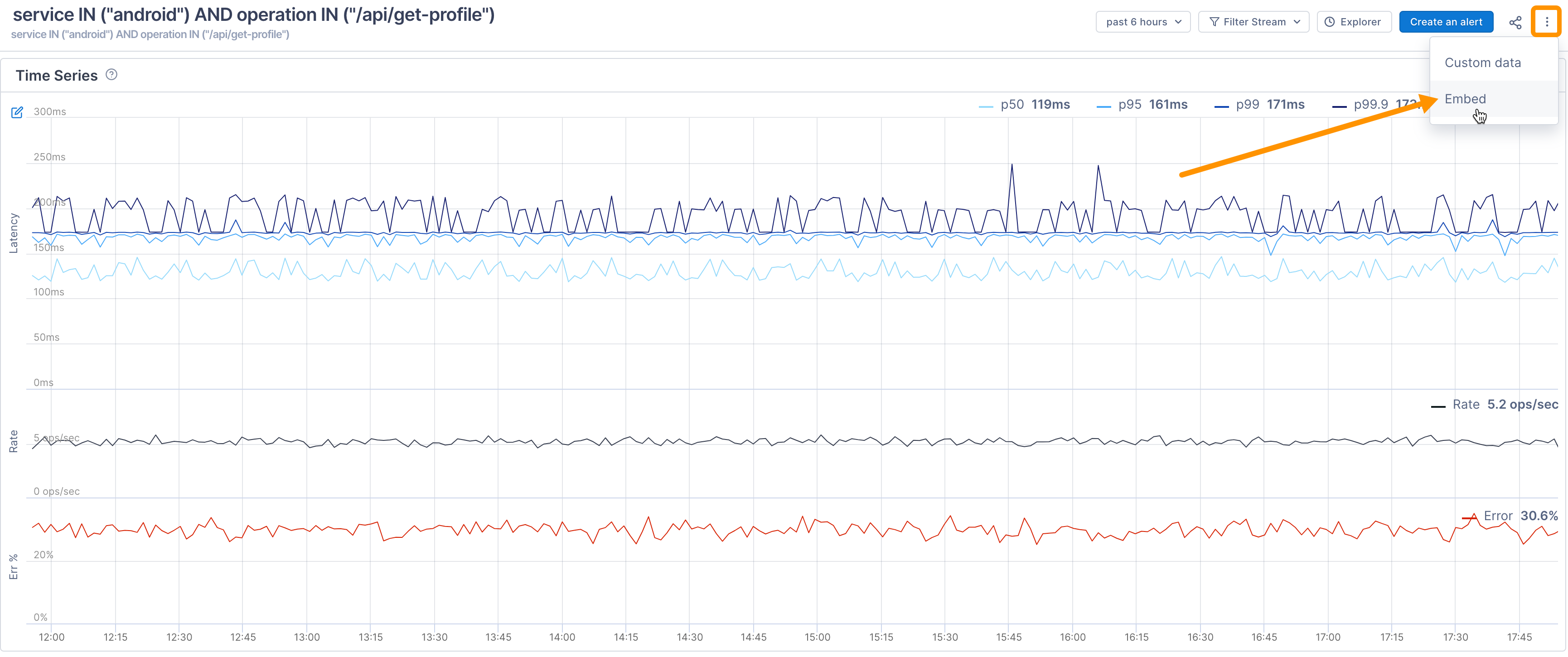
From a dashboard, click the gear icon for the Stream and choose Get embed URL.

-
If you want to use a dark version of the Stream, click Dark Theme in the dialog.
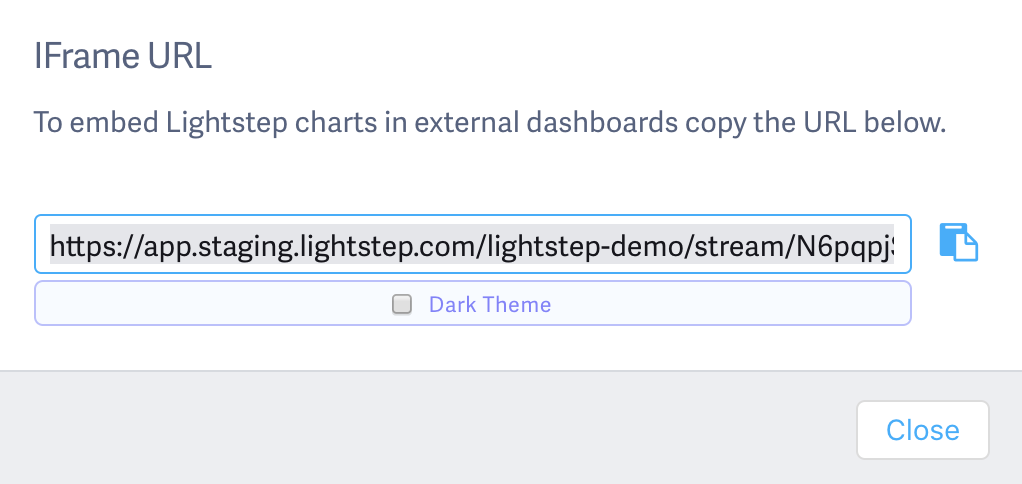
-
Copy the code and paste into the third-party app as needed. For example in Datadog, you can drag an IFrame widget onto a ScreenBoard and paste in the code from Cloud Observability.
See also
Updated May 10, 2022
